FINGERSTYLE/WHITE SWALLOW 'VINTAGE' FAQs
All Fingerstyle/White Swallow 'Vintage' model A-Scale banjos have a shorter than standard neck, frailing scoops and steel strings. Owner can change to nylon strings.
Here are some facts and info that may help answer your questions about this new Australian old-timey banjo.
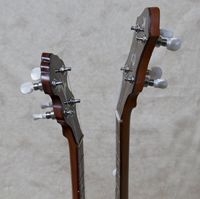 |
Q. What's the advantage of a shorter neck? | A. The primary reason is that you get a more 'cuddly' banjo; great for folks who are a bit fed up with stretching out with the chord hand. A shorter neck is simply easier to play and a lot less tiring on the chord arm. |
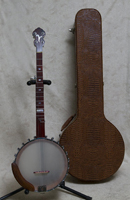 |
Q. If a shorter neck is good, why not make it REALLY short? | A1. The shorter the neck, the higher it needs to be tuned to avoid the strings going wobbly. (Imagine a mandolin next to a bluegrass banjo - one of the obvious differences is the string length - the shorter the string, the higher the pitch.) So, a very short neck banjo may not be able to play in G tuning at all. A2. When you shorten the neck on a banjo the bridge needs to be moved forward towards the fingerboard. This reaches the point of silliness! The 25" scale is a good length to give advantages without the disadvantages. |
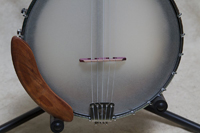 |
Q. What does 'scale' mean in this context? | A. It's the measurement from the crown of the bridge to the inside edge of the nut. Standard length for G-scale is 26 1/2". |
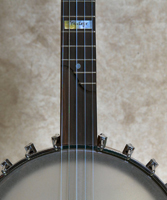 |
Q. Why is it called an A-scale? | A. The shorter string length of 25" allows the banjo to be tuned up to an A chord - traditionally one of the favourite keys for fiddle and mando tunes. Having said that, the Fingerstyle/White Swallow Vintage model is also completely happy in standard G tuning and has spikes fitted for those who use capos. Jam sessions in Australia often require frequent key changes, if only to suit the vocalists. |
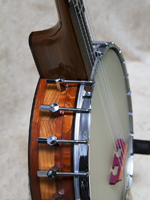 |
Q. Some clawhammer banjos have smaller diameter pots. Why did you stick with 11" ? | A. Partly because smaller diameter pots can sound a bit shrieky, partly because of the need to move the bridge forward a tad, and partly for player convenience - all the replacement parts you'll need (such as a new head) are readily available in Australia. |
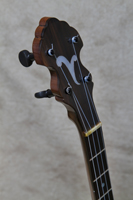 |
Q. The term 'vintage' is usually applied to banjos made before 1940. Why did you use this name for the new model? | A. Fingerstyle wanted to reflect some traditional aspects of A-scale banjos; that they're well suited to clawhammer and old-timey music and that all Fingerstyle Vintage models have frailing scoops, block rim construction, and wooden tone rings. |
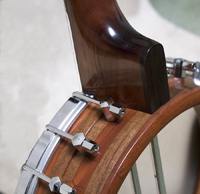 |
Q. Why dual co-ordinator rods? Surely a perch rod is more traditional for clawhammer banjos? | A. Well, as the Clifford Essex website states, banjo designers/makers don't want to keep making the same thing over and over. We've come a long way in understanding what makes a good banjo and frankly, dual co-ordinator rods make a lot of sense technically. |
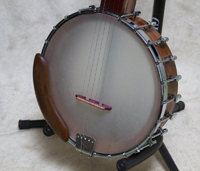 |
Q. There's a lot of talk on the chat rooms about nylon strings being hard to keep in tune and breaking easily. Why do people bother with them? | A1. Nylon or gut strings get a player closer to that authentic old-timey sound. But yes, if you've played ukulele or classical guitar you'll know all about the time it takes new strings to stretch! They're not for everybody. If you don't want to do the 'babying' thing with a banjo, go for steel strings. A2. Nylon is also kinder to your clawhammer picking fingernail. |
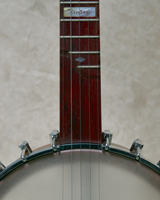 |
Q. Is there a fretless Vintage model available? | A. We can advise and collaborate to make you your own, unique, Vintage fretless, sure. |
REASONS TO CHOOSE THE 'VINTAGE' A-SCALE
- Made in Australia
- Designed by an experienced banjo player
- Made by an experienced craftsman
- Shorter neck for a more 'cuddly' banjo
- Less tiring to play
- Allows variety of different tunings
- Happy in G tuning for 'set n forget' picking
- Still allows capo use
- Allows choice of steel or nylon strings
- Warm, plunky sound
- 11" pot for easy sourcing of parts
- Block rim construction for strength
- Dual co-ordinator rods for stability and action adjustment
- Wooden tone ring for warm, plunky sound